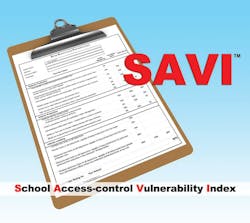Jorge D. Hevia, NAPCO Security Technologies, observed that there has seemingly been an accelerated problem of mass shootings in schools. While a governmental agency was formed after the events of 9/11, no similar centralized effort has been undertaken to address the school security issue. The Napco Whitepaper summarizes school security issues and offers an unbiased, standardized plan for measuring and implementing heightened security in schools.
The Napco Whitepaper outlines the need for a national school security association and the need for the security industry to develop a unified process for addressing the active shooter problem. To this end, the Napco Whitepaper launches the School Access-Control Vulnerability Index (S.A.V.I.) ™. S.A.V.I. is comprised of a an audit which contains a series of questions. The questions indicate how well-prepared a school facility is to defend against unwanted intrusion. Trained evaluators would then study each audit and suggest security measures to be taken if needed.
According to the White Paper, the amount of individual school shootings has steadily increased during the last few decades. While each incident momentarily receives public attention, the White Paper explains that public opinions about gun control and mental health have tended to detract attention from the basic issues involved in securing our schools.
An underlying fact in most school shootings is that the intruder had entered the building well-supplied with weapons and ammunition and had free movement for a reasonable amount of time. The Napco White Paper states that the first course of action to prevent this possibility would be to develop a secure system for controlling school building access. While a national program was implemented after 9/11 to control individual access to gates at airport, no similar national program exists to control access to most schools. The Napco White Paper suggests the development of a national school security association similar to the National Fire Protection Association (NFPA). The national school security association would implement codes and standards for securing school buildings.
Since there is currently no centralized body which addresses school security, implementation of school security is often left to local school districts. The Napco White Paper indicates that this approach is inconsistent at best. School districts may depend on a local security professional who also may not be specialized in every security area required to complete the security of a school building. The White Paper explains various specialties of companies within the security channel including Integrators, Fire Alarm dealers, CCTV dealers and Locksmiths.
The Napco White Paper suggests that solutions currently exist to prevent active shooters from entering a schhool. However, this information has not currently been disseminated in a standardized manner to school decision-makers. In order to provide a standardized procedure for judging school security preparedness, a S.A.V.I. index worksheet has been developed. General topics include exterior protection, interior protection and interior locking. After answering yes or no to the 17 questions, the worksheet will quickly indicate the strengths and weaknesses of a school security plan.
This review of the Napco White Paper and the S.A. V.I. School Access-Control Vulnerability Index only includes a small portion of Napco Security Technologies ideas and suggestions for increasing security in school buildings. Read the complete whitepaper, titled Impediments to U.S. Educational and Public Institutions Ameliorating the Mass Shooting Epidemic with Effective State-of-The-Art Security Solutions and the Introduction of a School Access Control Vulnerability Index (S.A.V.I.™) Audit and Certification Process as a Solution, online at www.locksmithledger.com/11305393






